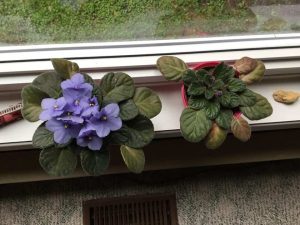African violets with their vibrant blossoms and lush foliage are a popular choice among houseplant enthusiasts. But it can be disheartening to witness the leaves of these beautiful plants falling off.
Leaf loss in African violets can be attributed to various factors ranging from environmental conditions to pests. Understanding the causes behind this issue is crucial for maintaining the health of your African violets.
In this post, we will explore the most common reasons why African violet leaves may fall off and provide practical solutions to promote better growth and well-being.

10 Causes of African Violet Leaves Falling Off
Overwatering
Overwatering is a common mistake that can lead to African violet leaf loss. When the soil is excessively wet, the roots can become waterlogged. The soil condition will suffocate the plant and cause root rot.
This hampers the plant’s ability to absorb nutrients, resulting in weak leaves that eventually drop off. Allow the soil to partially dry out before watering again.
Ensure proper drainage by using a well-draining potting mix and a container with drainage holes. These holes will help drain excess water from the potting mix.
Underwatering
Underwatering is another culprit behind leaf loss in African violets. Insufficient watering can cause the leaves to wither and drop off prematurely.
To maintain proper moisture levels, water the plant when the top inch of the soil feels dry. Avoid letting the soil completely dry out, as it can stress the plant.
Use room-temperature water and water the plant from the bottom, allowing it to soak up moisture through the drainage holes for optimal hydration.
Lack of Humidity
African violets are native to humid environments, and low humidity levels can lead to leaf drop. Dry air can cause the leaves to lose moisture rapidly, leading to dehydration and subsequent leaf loss.
Increase humidity around your African violet by placing a water tray near the plant or using a humidifier. Grouping plants together can also create a microclimate with higher humidity.
You can also mist the leaves occasionally to provide a gentle moisture boost. But ensure the plant is placed in a well-ventilated room to prevent fungal growth.
Direct Sunlight Exposure
African violets thrive in bright indirect light. But excessive exposure to direct sunlight can cause leaf damage and loss. Intense sunlight can scorch the leaves, leading to browning, wilting, and leaf drop.
Place your African violet in a location that receives bright, filtered light, or use sheer curtains or blinds to diffuse direct sunlight. Rotate the plant regularly to ensure even light distribution.
High Temperature
African violets prefer moderate temperatures and are sensitive to extremes. High temperatures can stress the plant, causing leaves to become wilted and drop off.
Avoid placing African violets near heat sources such as air vents. Maintain a temperature range of 65-75°F (18-24°C) during the day and slightly cooler temperatures at night to prevent leaf loss due to heat stress.
Pest Infestation
Pests can wreak havoc on African violets, leading to leaf damage and loss. Common pests that affect these plants include aphids, mealybugs, spider mites, and thrips.
These insects feed on the sap, weaken the leaves, and can transmit diseases. Inspect your African violets for signs of infestation and take immediate action.
Use organic insecticidal soaps or neem oil to eliminate pests while minimizing harm to the plant. Be sure to isolate your African violet from other indoor plants.
Leaf Diseases
Leaf diseases can also contribute to African violet leaf loss. Fungal infections such as powdery mildew or bacterial diseases can cause discoloration, spotting, and deterioration of the leaves.
Ensure good air circulation around the plant and avoid overhead watering, as wet foliage can promote disease development. If you notice signs of disease, promptly remove and destroy infected leaves.
Treat the plant with appropriate fungicides or bactericides. Isolate your African violet plant to prevent the spread of leaf diseases.
Natural Aging Process
African violet leaves have a natural lifespan as they age. They will naturally turn yellow and drop off. This process is a part of the plant’s growth cycle and is nothing to be alarmed about.
New leaves will emerge to replace the older ones. However, if excessive leaf loss occurs without new growth, it may indicate an underlying issue that requires attention. (Source: African Violet Society).
Overfertilization
Overfertilization can be detrimental to African violets, causing leaf loss and other symptoms of nutrient imbalance. Excessive fertilizer application can lead to salt buildup in the soil, which can burn the roots and interfere with nutrient absorption.
Follow a balanced fertilizer regimen specifically formulated for African violets, and dilute the fertilizer according to the instructions. Flush the soil occasionally to remove any accumulated salts.
Wrong Soil Type
Using the wrong soil type can impede African violet growth and lead to leaf drop. These plants require well-draining, loose soil with good water retention.
Avoid heavy garden soils as they can retain too much moisture, leading to root rot. Instead, opt for a specialized African violet potting mix or create your own by combining peat moss, perlite, and vermiculite.
Final Thoughts from Experts
To prevent African violet leaves from falling off, it is crucial to maintain a balance of moisture, light, humidity, and temperature. Regularly monitor your plants for signs of stress, pests, or diseases, and take appropriate action.
Providing proper care, including watering correctly, providing adequate humidity, and protecting them from direct sunlight and extreme temperatures, will contribute to healthy growth and minimize leaf loss.
Remember to rotate your African violets regularly and repot them when needed to ensure optimal root health. With the right care and attention, your African violets will thrive, gracing your indoor spaces with their vibrant foliage and beautiful blooms.
People Who Read This Also Read:
- African Violet Leaves Drooping (Causes & Solutions)
- African Violet Leaves Curling (Causes & Solutions)
- African Violet Leaves Turning Yellow (Causes & Solutions)
- African Violet Leaves Turning Brown (Causes & Solutions)
- Brown Spots on African Violet Leaves (Causes & Solutions)
- African Violet Not Flowering (Causes & Solutions)
- How to Care for African Violets Indoors






